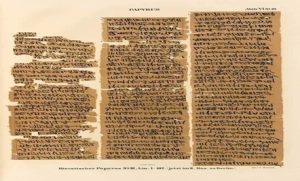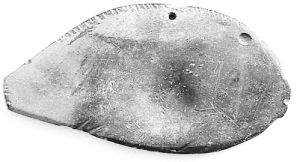Ancient Egyptian History
Ancient Egyptian History Ancient Egyptian history is divided into two main periods: the prehistoric period (or pre-dynastic period) and the dynastic period.
Pre-Dynastic Period
The pre-dynastic period is further divided into two phases: The Early Prehistoric Period: This period spans from 21,000 BC to 17,000 BC. During this time, humans lived in caves, gathering wild plants and hunting animals. They depicted these activities in primitive rock art. A significant development during this phase was the discovery of fire, which marked a transition from a primitive to a more advanced way of life.
The Late Prehistoric Period
This phase extends from 17,000 BC to around 3200 BC. It is characterized by the emergence of agriculture, domestication of animals, and the production of pottery for storing grains. Additionally, settled communities began to appear in Egypt, and the Egyptians started using mud bricks for construction.
A Notable Discovery
One of the most significant findings from this period is Gebel el-Arak knife. Discovered in the Gebel el-Arak region south of Abydos, this flint knife is adorned with gold leaf. It depicts scenes of land and sea battles, providing crucial evidence of interactions between ancient Egyptian civilization and the civilizations of Mesopotamia (Sumer). A magnified view of an ivory knife handle depicts the earliest recorded naval battle in history. This knife, famously known as the Gebel el-Arak knife (located south of Abydos), dates back to the pre-dynastic period and is over 5,000 years old.
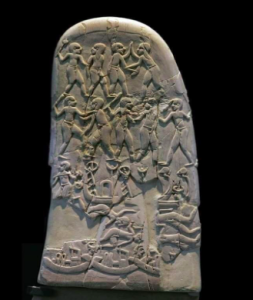
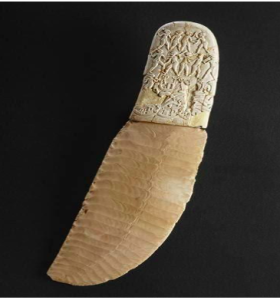
Naqada Pottery
Naqada experienced a notable improvement in pottery production. The British archaeologist, Flinders Petrie, considered Naqada pottery to be the final stage of the pre-dynastic period. Pottery with white decorations and colored pottery depicting boats, oars, and water waves were produced. There was also advancement in the production of weapons, such as knives and arrowheads. The production of grinding palettes, often shaped like fish and used for grinding eye makeup, flourished. Additionally, there was a development in the production of jewelry and amulets made of ivory. ” Petrie named the elaborately decorated pottery of the late pre-dynastic period ‘D ware’. Unlike the pottery made from Nile River clay, D ware was crafted from desert clay. Its decorations, painted in a reddish-brown hue, featured stylized rows of hills, animals, and boats, sometimes accompanied by human figures. These vessels often had triangular handles adorned with boats bearing emblems, and their tops were decorated with hill-like symbols. The Naqada culture was the most prominent during this period.”
The Naqada Civilization
The period between 4000 BC and 3200 BC is known as the Naqada I and II periods. Naqada is a small city located approximately 30 kilometers north of Luxor. During this time, villages transformed into small cities, population density increased, and Egyptians made significant advancements in pottery industry and stone tool use.
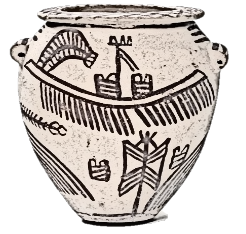
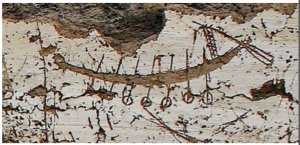
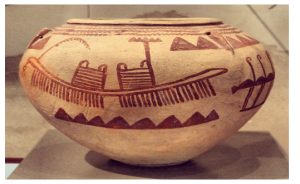
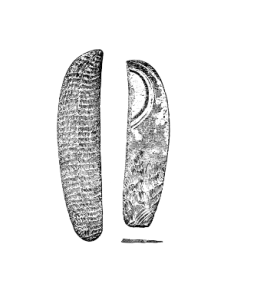
Scorpion King
The recently released film, “The Scorpion King,” is believed to be inspired by an actual Egyptian king from the late pre-dynastic period. Scholars suggest that the film’s character is based on a real historical figure. A relief depicting King Scorpion has been discovered. He was the last pharaoh to rule Upper Egypt before the unification of Egypt around 3200 BC. Beside his image, there is a representation of the goddess “Selket”, often symbolized by a scorpion. Legends portray King Scorpion as a skilled and courageous warrior who led a rebellion against a tyrannical ruler who had oppressed his people. After seizing power, King Scorpion is said to have ruled justly. His death is estimated to have occurred around 3280 BC. Following King Scorpion’s death, instability arose in the north. Eventually, King Narmer emerged and conquered the northern kingdom, unifying Upper and Lower Egypt
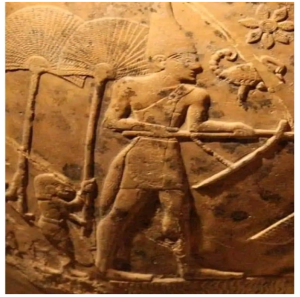
THE UNIFICATION OF EGYPT
As previously mentioned, ancient Egypt was divided into Upper and Lower Egypt. The Egyptians referred to their land as “the two lands.” The capital of the south was the city of Nekhen, meaning “fortress” or “castle,” located north of Edfu. Its deity was Horus, and its emblem was the white crown. The sacred plant was the papyrus, which was later used in writing, and its symbol was Nekhbet, the vulture goddess, represented by a lotus flower. The northern kingdom was situated in the Delta region, with its capital at Buto, meaning “throne.” Its crown was red, and its emblem was the bee. The deity was also Horus, and its animal symbol was the serpent. Its sacred plant was the papyrus. King Narmer (or Menes) united Upper and Lower Egypt. This victory was recorded on his famous palette, now known as the Narmer Palette. From this point forward, the dynastic period of Egypt began, spanning from the First to the Thirtieth Dynasties, from 3200 BC to 332 BC when Alexander the Great conquered Egypt. Menes established his capital at Thinis, near Abydos, and wore the double crown, combining the symbols of both Upper and Lower Egypt: the white and red crowns, the papyrus and lotus plants, and the serpent and vulture.

The Narmer Palette
The British archaeologist James Quibell discovered the Narmer Palette at the site of elkom alahmer in Aswan in 1898. •The Palette’s Description: On one side, we see a repeated image of a woman’s face with cow’s ears (representing the goddess Hathor) and the facade of a palace (the serdab). To the left, the king is depicted in a victorious procession, holding the head of his enemy in one hand and a mace in the other, symbolizing his conquest of the Delta. Horus, in the form of a falcon, is shown seizing the heads of enemies, signifying that the king had become Horus’s chosen ruler on Earth. A unique scene depicts a servant holding the king’s sandals, indicating a ceremonial act within a temple. •The Reverse Side: The other side of the palette shows an elevated view of the king, with attendants carrying standards. Below, there are decapitated bodies of enemies. Beneath the king, we see a battle between two mythical creatures, symbolizing the unification of Upper and Lower Egypt under the king’s rule. In the final scene, the king is depicted as a ram attacking a city, with enemies beneath his feet.
The Early Dynastic Period: The First and Second Dynasties
After the death of King Menes, his sons and grandsons ruled Egypt and were buried in Abydos. Their tombs were mastabas constructed of mud bricks. A significant characteristic of the First Dynasty was that, for the first time in world history, a woman ruled a great nation like Egypt. Queen “Merneith” ascended to the throne around 2990 BC after the death of her husband and due to her son’s young age. She ruled independently and maintained her influence even after her son, King Den, came of age. Following the reign of Den, the First Dynasty ended and the Second Dynasty began. Together, these two dynasties ruled for approximately 300 years. There were no particularly notable events during this period, except for a civil war between the north and south during the reign of King “Khasekhemwy”. King Djoser eventually reunited the country and moved the capital to Memphis in central Egypt, marking the beginning of the Old Kingdom around 2630 BC.
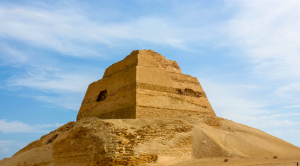
Pyramid of king Huny
King Sneferu

Sneferu, King of Pyramid, Fourth Dynasty
King Sneferu Sneferu, the founder of the Fourth Dynasty, was a remarkable pharaoh who ushered in a new era of Egyptian civilization. He was known for his expertise in foreign trade and mining, but his most enduring legacy lies in his architectural achievements. Sneferu constructed of four pyramids. The first, a smaller structure in the Fayum region, served as a symbolic tomb. The second, located at Meidum near Saqqara, was unfortunately left unfinished. The third pyramid, renowned for its unique design, is often referred to as the Bent Pyramid. Situated in Dahshur between Meidum and Saqqara, this pyramid is characterized by its distinctive shape, with a change in angle halfway up. Sneferu’s fourth pyramid, also located in Dahshur, holds the distinction of being the first complete pyramid in the history of Egyptian civilization. Known as the Red Pyramid due to the reddish hue of its casing stones, or alternatively as the North Pyramid, this structure stands as a testament to Sneferu’s architectural innovations.
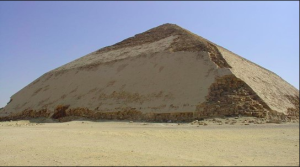
Pyramid of King Sneferu,
The Meidum Geese painting
The Meidum Geese If Europeans pride themselves on the Mona Lisa, then Egyptian civilization takes pride in the Meidum Geese, considered more beautiful than the Mona Lisa. Discovered in one of the mastabas of a noble from the Fourth Dynasty, it now resides in the Egyptian Museum in Cairo, showcasing the beauty of Old Kingdom art. It depicts six geese, three of which are on the right and three on the left, feeding. However, anyone who looks at them would believe they are alive and that it is not merely a painting.
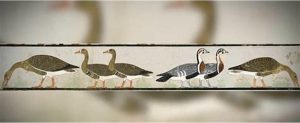
King Usorkaf
Usorkaf king the of statue granite a of head Huge King Usorkaf Usorkaf was the first king of the Fifth Dynasty, and for the first time, a religious temple was connected to a mortuary temple. The significance of this king lies in his being the first to promote the worship of the sun god Ra. Statue of King Usorkaf Discovered in 1957 in Saqqara, near this king’s pyramid, it is a massive head of a statue made of pink granite. This head is considered the only known example of a statue of such a significantly larger-than-life size in the Old Kingdom. Notably, this statue is one of only two in the Egyptian Museum and one of the very few statues that depict a mustache. For ancient Egyptians, it was customary to depict kings with beards, not mustaches.
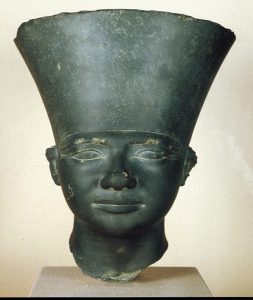
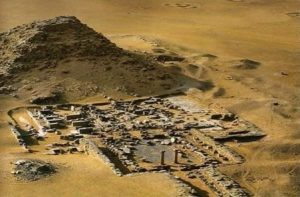
King Sahure
He succeeded King Userkaf to the throne, and it is said that he was his brother. He is considered one of the warlike kings; for a stela was found in the Sinai Peninsula depicting him wearing the Upper Egyptian crown and striking the Asiatics. Also, an inscription bearing his name was found in Thomas in Nubia, indicating that the borders of his kingdom did not end at the first cataract. Moreover, the inscriptions found in the sun temple he built at Abu Sir suggest that he sent a fleet to the coast of Phoenicia. And towards the end of his reign, the Palermo Stone mentions that he sent a trade mission to Punt, which returned with perfumes, gold, and ebony. The most significant building he erected was the great sun temple at Abu Sir, near Memphis. This temple served as a distinctive model for the temples of the kings of the Fifth Dynasty and was located near the pharaoh’s pyramid. It was adorned with new column designs. The phenomenon of the false door in tombs also became known during his reign.
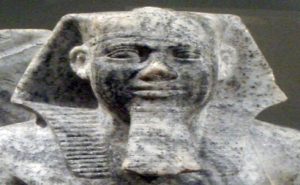
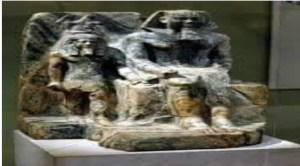
King Unis (Onnos)
Unis is considered by historians to be the last and one of the greatest kings of the Fifth Dynasty. He reigned for approximately thirty years. His fame primarily rests on his pyramid at Saqqara, where in 1881, Auguste Mariette discovered his sarcophagus in the burial chamber. The walls of the chamber were adorned with scenes depicting spells and religious prayers, which later became known as the Pyramid Texts. These texts evolved over time and eventually culminated in works like the Book of the Dead. They have become one of the most important sources for understanding ancient Egypt. Literature in the Old egypt One of the most important papyri dating back to the Fifth Dynasty is the Papyrus Prisse. It is a collection of advice about human relationships, given by Ptahhotep, a father, to his son. 1 Several copies of this papyrus have been found, with one on display at the National Library of France in Paris. There are significant differences between the Papyrus Prisse copy and the two texts preserved in the British Museum. “Batiscombe Gunn” published a translation of it in 1906 as part of a series of books titled “Wisdom of the East.” Teachings of the Egyptian Sage Ptahhotep: “If you become a successful man, build yourself a house and take a wife who will be the mistress of your heart. Satisfy her belly, clothe her back, and give her the finest perfumes. Bring joy to her heart as long as you live. For a wife is a fertile field for her husband. Do not complain about her in court, do not use force or violence against her, and do not force her to stay in the house. Be gentle with her when she weeps.”
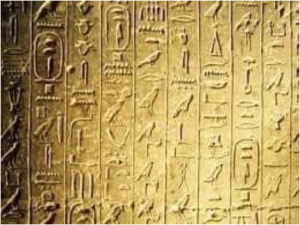
The Sixth Dynasty: King Pepy I
King Pepy I was the most significant ruler of the Sixth Dynasty and reigned for fifty years. He left behind numerous inscriptions in quarries and artifacts from his era. He also subdued the Bedouin tribes in the deserts. He was so beloved that Egyptians throughout the ages have named their children “Pepy,” meaning “little child.”

Life-size statue of King Pepe I copper at the Egyptian Museum in Tahrir
King Meren Ra
After King Pepy I, his son Meren Ra assumed the throne. When he ascended, Meren Ra was still a young boy, approximately 7 years old. His reign lasted less than twenty years. The significance of this king lies in the discovery of his intact mummy when his pyramid was opened around 1880. This was, in fact, the first pharaoh’s body to be found relatively intact until that time. Although thieves had stripped the mummy of its wrappings in ancient times, a lock of youthful hair was still attached to the skull, indicating that Meren Ra was indeed a child when he di
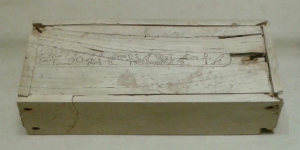
Ivory box of King Meren Ra at the Louvre Museum in Paris
The First Intermediate Period
This era was characterized by a lack of a centralized ruler, instead being governed by a multitude of regional rulers. Each provincial governor essentially ruled over their own domain. It was during this period that a new literary genre emerged: the Coffin Texts. While pharaohs during the Old Kingdom had constructed pyramids and inscribed religious texts like the Pyramid Texts on their walls, as seen in the tomb of King Unis, these regional rulers built tombs and adorned their coffins with these newly developed texts. One of the most notable features of this period was the prevalence of uprisings. As is common with revolutions, these uprisings led to significant societal upheaval. As a result, a rich body of literature emerged, with some of the most famous examples being the Satirical Letter, the Instructions of Ipuwer, and the Lamentations of a Peasant. 1-Ipuwer Papyrus: Discovered in Memphis and now housed in the Leiden Museum in the Netherlands, this papyrus provides a vivid account of the state of the country. It describes how the Bedouin were threatening roads and secure cities, and advises the ruler to become a father to all. The papyrus also laments the loss of order, stating that the ignorant (regional governors) had seized power from the kings. It mentions the cessation of trade with Phoenicia and Nubia, with no more wood or oil being imported. It describes a society in decline, where brothers killed brothers, crops failed, and people suffered from poverty and deprivation.
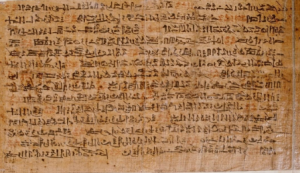
Papyrus of the eloquent farmer
Found in four copies, three of which are in Berlin and one in the British Museum, this papyrus consists of nine complaints from a peasant whose property was seized by the servants of his village governor. Despite seeking justice from the village governor and the temple, he faced threats, beatings, and imprisonment. Ultimately, he appealed to the provincial governor, who resolved the issue and punished the wrongdoers.
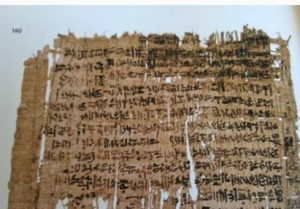
Life of despair of Papyrus
Preserved in the Berlin Museum, this papyrus contains four poems expressing deep despair and pessimism. The first laments the lack of respect for the poor, while the second describes a world of treachery and betrayal. The third poem is a hymn to death, marking the first instance in ancient Egyptian literature of a longing for death. The final poem is a lament about the hopelessness of life and suggests that patience is the only solution to these problem
